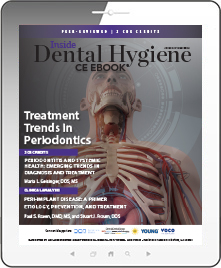Treatment Trends in Periodontics
Released: Monday, June 14, 2021
Expires: Sunday, June 30, 2024
Commercial Supporters: DirectaDentalGroup, VOCO America, Young Dental, Paradise Dental Technologies, Dental Care Alliance
This Inside Dental Hygiene eBook features a continuing education (CE) article that explores recent evidence of periodontal-systemic interaction and highlights some of the emerging trends in the diagnosis and treatment of periodontal diseases, such as point-of-care diagnostic technologies and advanced host immuno-inflammatory response modulation strategies. An accompanying article describes how clinicians must be familiar with the etiology and risk factors for peri-implant mucositis and peri-implantitis as well as how to properly diagnose and treat these two clinical entities in their earliest stages. Download to earn 2 FREE CEU now!
FEATURED CONTENT
CE: Periodontitis and Systemic Health: Emerging Trends in Diagnosis and Treatment
Maria L. Geisinger, DDS, MS
The WHO has identified chronic inflammatory conditions as the largest threat to public health, and ongoing research continues to suggest that periodontitis elevates proinflammatory markers systemically. Recent studies have linked the presence of periodontitis to hypertension and the severity of symptoms from COVID-19 infection. This article explores some of the recent evidence of periodontal-systemic interaction and highlights some of the emerging trends in the diagnosis and treatment of periodontal diseases, such as point-of-care diagnostic technologies and advanced host immunoinflammatory response modulation strategies.
Credits: 2 Self-Study CEU
Cost: $0
Provider: Conexiant Education
Peri-Implant Disease: A Primer
Paul S. Rosen, DMD, MS, and Stuart J. Froum, DDS
Although reported rates vary, studies have shown that peri-implant diseases are prevalent among patients who have received dental implant treatments. In a retrospective study that assessed implant recipients at 9- to 14-years postoperatively, peri-implant mucositis was present in 48% of the implants and peri-implantitis was identified in 6.6% of the implants. To help reverse this trend, clinicians must be familiar with the etiology and risk factors for peri-implant mucositis and peri-implantitis as well as how to properly diagnose and treat these two clinical entities in their earliest stages.
